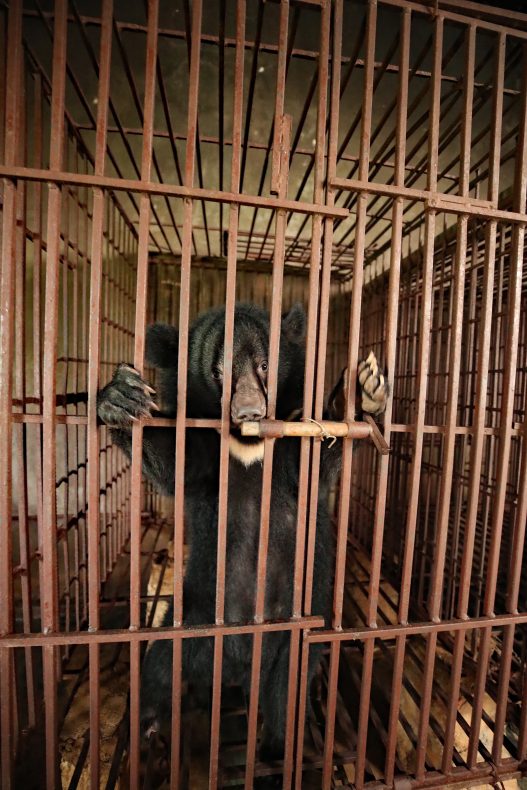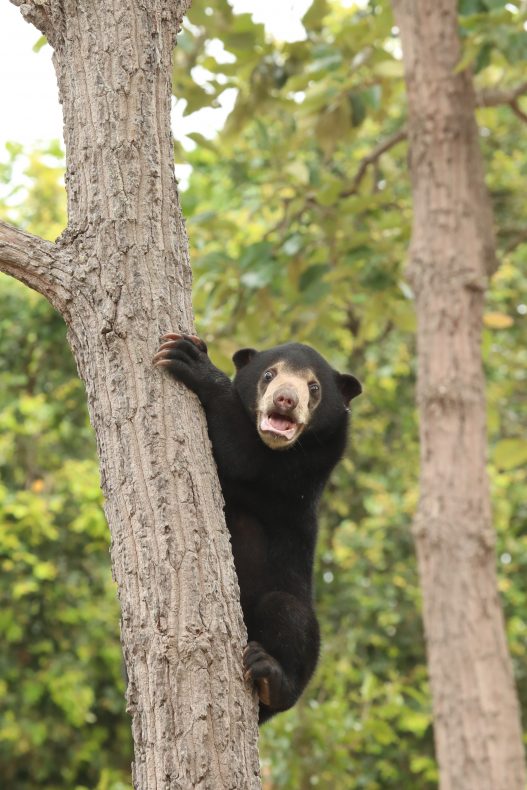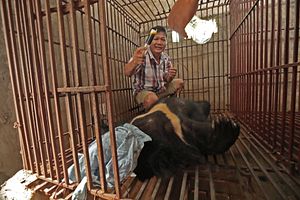Education for Nature – Vietnam’s (ENV) Wildlife Crime Unit recently enabled the rescue of the “Nghe An Three” in one of the most protracted and violent bear bile rescues to date. This positive outcome is offset by the knowledge that 10 bears were left behind despite video recordings of bile extraction for commercial purposes, evidence that the bears are not microchipped (suggesting they were poached from the wild), and their dealer’s internet bear bile hotline still being open for business.
Vietnam’s Asiatic Black Bears face the most severe declines recorded, with numbers dropping by over 60 percent in 30 years. With bear bile farms “heavily reliant on restocking from wild populations,” the Vietnamese government has committed to a plethora of laws, regulations, and guidelines to protect them.
However, it’s clear from the Nghe An Three case that poached bears are still filtering onto farms. What are the mechanisms allowing this to happen? With Vietnam’s failure to execute the law in the face of overwhelming evidence, what is preventing the discovery and confiscation of illegal bears? And finally, is there a future for this overlooked conservation icon and can the illegal wildlife farmers play a role?
Bear Farming Beginnings and Conservation Efforts
Bear bile was originally used in Traditional Chinese Medicine to treat fevers, pain, convulsions, and hemorrhoids, with the treatment suggestion appearing in the first official Chinese pharmacopoeia in 659 CE and later spreading to Vietnam. Ursodeoxycholic acid is the pharmacologically active ingredient, and with bear bile containing between 1-39 percent of this acid compared to less than 0.5 percent in other vertebrates, they became the animal of choice. Once Koreans developed the infamously cruel methods of extracting bile from live bears, urban growth ignited Vietnam’s bear farming in the 1990s. Although farming bears was pitched as a conservation tool, consumers consistently prefer wild-sourced bile, farms are restocked by poaching, and a survey reveals a simultaneous wild stock decline.
Vietnam became a signatory to CITES in 1994 with Asiatic Black Bears (Ursus thibetanus) and Sun Bears (Helarctos malayanus) being given Appendix I status, providing top-level protection from international trade. As Vietnam is a consumer, source, and transit country, CITES failed to protect these bears from domestic trade. Farms of these vulnerable species became nothing more than laundry facilities for wild bears.
Although technically illegal since 1992, Vietnam locked down legislative loopholes, prohibiting the commercial exploitation of bears in 2006. In tandem with a 2005/2006 compulsory microchip and registration program for farmed bears, a big step forward was taken to stem the tide of poached bears entering farms. Although farmers were allowed to keep bears, with no legal avenue for financial benefit it created a rather dubious situation, particularly as, according to Nguyen D. T. Minh, co-author of TRAFFIC’s 2016 report, farmers still had to pay feed costs. This created both the incentive and opportunity for bile extraction.
With Animals Asia signing Memorandums of Understanding (MOU) in 2015 to end bile prescriptions and in 2017 to rescue remaining bears by 2022 at the latest, the pressure should be creating definitive momentum to end bear farming once and for all. However, with academic surveys revealing a roughly eight-year life span for captive bears, alarm bells should be ringing that around 800 registered bears are still alive 14 years after the 2005 microchip program began. As 95 percent of bear owners admit to still extracting bile, this extended life span can’t be attributed to healthier conditions. Logic determines poached bears are still replenishing farm stocks. Yet NGO interviews reveal a lack of consensus that un-microchipped bears exist.

This poached wild bear at the “Nghe An Three” farm could be trapped for life in Vietnam’s bile industry. Photo by Kate Fox.
Smoke and Mirrors
The discovery and confiscation of illegal bears in Vietnam is a disorientating game of smoke and mirrors. Evidence from the “Nghe An Three” case that farmers shuffle bears between premises supports the idea that in tight-knit rural districts like Quynh Luu in Nghe An province, farmers might provide cover for each other when the authorities give notification of bear farm inspections. Professor David Canter, creator of Investigative Psychology, believes that “clearly the local community is needed to support that illegal trade, benefitting from it, probably not thinking there is anything wrong with it.” With under-the-table sales of bile in medicine shops and blatant online bile advertising permitted, one can understand how this might be viewed as passive endorsement of their crimes.
Statistics are vital for directing responses but accurate confiscation data doesn’t exist and might not reflect the true quantity of illegal bears. According to Vietnam’s NGOs, when un-microchipped bears are detected, farmers offer unverifiable explanations to avoid fines: the vet was unavailable to fit the microchip; the chip has been damaged; the bears were bred in captivity. If authorities overcome this cat and mouse hurdle, instead of confiscating the bears, they try and persuade the criminals into a “voluntary transfer” to keep the peace. Tuan Bendixsen, director of Animals Asia Vietnam, says that otherwise, the government “would need a large contingent of police, rangers, central and local authorities” to confiscate a bear. Unfortunately, this lax enforcement creates a sense of confusion over the bear’s true legal status. Ha Bui, ENV’s vice director, emphasizes that “the law cannot be successfully applied through negotiations with criminal traffickers.”
Despite 95 percent of bear owners admitting to extracting bile, only 5 percent have been fined. Bendixsen further discloses there’s “only been once known case of [a] bear confiscated from bile extraction” and that discovering unchipped bears is “not common unless they got caught in the act of transport.” This weak enforcement, combined with a heightened awareness of legislation since the Hanoi Illegal Wildlife Trade Conference in 2016, is driving trade further underground. According to Rosa Indenbaum, formerly TRAFFIC’s senior program officer for wildlife crime, it’s created an “artificially cleansed” industry.
Indenbaum believes it’s important “not to equate the lack of observation with a decrease in market,” particularly when TRAFFIC’s 2016 report reveals “unconfirmed statements” that for 272 registered bears, there were 162 illegal unchipped bears. She explains few organizations “have the proper expertise and training to conduct those infiltrated underground surveys” and with the Communist Party of Vietnam further suppressing media investigations, it’s easy to see how illegal bears might go unreported.
How Poached Bears Enter Farms
To understand the mechanisms allowing poached bears to filter onto registered farms required undercover investigation. After initiating contact via a farmer’s bear-bile internet site, the “Nghe An Three” were soon discovered as part of 13 bears on two closely located farms. My translator recounted that the farmer “had got bears from Laos when [they were] 1 kg. Now [they are] 3 years old…apart from 7 month cub.” The Nghe An-Laos border is notoriously porous, making it a wildlife trafficking hotspot. Cramped in small cages, the nine bears on Farm 1 were visibly too young to be microchipped, a fact confirmed by Emily Lloyd, Four Paws’ animal manager, who attended their rescue. Although three supposedly had damaged microchips, she states “it was pretty sad to have to leave the others behind, especially seeing that some were also young and therefore illegal.”
Dr. Johanna Painer from Vetmeduni, Vienna, states that once bears reach 5 years old, it’s hard to tell their age. “Even teeth are not reliable indicators as they vary so much,” she explains. This crucially important fact enables poached bears to be filtered onto registered farms at 5 years, and visibly pass as older, chipped, and legal. Segregating young bears onto “hot” illegal rearing farms like Farm 1 reduces the risk of capture, making perfect criminal sense.
Of course, this all hinges on authorities not scanning microchips. Dr. Karanvir Kukreja, World Animal Protection’s (WAP) former wildlife campaign manager, states that, despite using “the best technology available at the time,” microchips could only be read from 10-20 cm, requiring bears to be anesthetized for scanning. Kukreja explains that instead the Forest Protection Department (FPD) were “often just checking characteristics of the bears and comparing them to a previous list.”
Since 2016, WAP have fitted advanced technology microchips to 599 bears, preventing criminals from claiming any bears over 5 years old are legal. Pre-empting other loopholes now becomes crucial. With a recent change of the law allowing people to keep farm-born cubs, this provides an alternative cover story for unchipped bears. Similarly, dead bears are supposed to be reported to the authorities for official disposal but Minh states “that is not something the government stress caring about,” ultimately enabling body parts to be sold on the black market.
Law enforcement is the cornerstone for future success, yet at times it’s a dangerous task. Two women – including Ha Bui of ENV – were targeted in a violent riot and attempted kidnapping at the Nghe An Three Commune. Ha recalls how an aggressive crowd, armed with stones and bricks, attempted to set fire to their car with them inside and hold them hostage in the church, despite government officials being present. With Nghe An’s rule of law in jeopardy, one must question why illegal wildlife farmers feel able to break the law with such impunity.
ENV’s cooperation with law enforcement provides valuable insights into this underworld. Ha discloses that one “problem that they are facing is… the Catholic issue.” The farm in the Nghe An Three case is in the heart of a Catholic area. With Catholics making up just 6.6 percent of Vietnam’s population and being on the receiving end of oppression and persecution, law enforcement in these communities is a “very sensitive issue.” Ha reveals the authorities are consequently struggling with whether to “aggressively deal with that, or to just step back, like to avoid another incident.” It’s unclear whether the illegal wildlife criminals are aware of this, but the balance of power has shifted, allowing riots to go unchallenged and illegal bears unconfiscated.

Poachers in Cambodia killed this sun bear’s mother and took the cub into captivity for the bear bile industry. Fortunately for the cub, it found its way into the hands of villages who gave her to the local Free the Bears charity. Photo by Kate Fox.
Hope for the Future?
Vietnam’s bear bile industry has decimated this once widely distributed and abundant species. With rescued bears too damaged to be returned to the wild and their breeding controlled, bear sanctuaries cannot redress this balance. Sluggish law enforcement remains largely to blame for the continued practice. ENV is keen to lift the veil of protection that allows wildlife criminals to operate beyond the rule of law, potentially allowing the rescue of the Nghe An Three’s cellmates and disabling this wildlife trafficking stronghold. Going forward, Vietnam must commit to unannounced spot-checks and swift confiscations, regardless of excuses presented, otherwise they will remain a toothless tiger on the law enforcement stage.
For Vietnam’s conservation reputation to be taken seriously, their international political messages must tally with events on the ground. Dr. Ha Cong Tuan, Vietnam’s deputy minister of agriculture and country development, said that “we do not have enough intelligence and evidence to deal with the crimes” while at London’s Conference on Illegal Wildlife Trade in 2018. Yet despite the impending 2022 deadline to rescue Vietnam’s remaining bears, illegal bears remain unconfiscated in the face of overwhelming evidence on multiple fronts.
Assuming this MOU comes to fruition and registered farms close in 2022, the “dead bear” loophole must be closely controlled, as evidence reveals that 51 percent of farmers admitted to killing bears when closing farms. The deeply ingrained traditional medicine beliefs combined with emerging alternative ones won’t disappear overnight and could create a deeper network of illegal bears after 2022.
However, charities are making significant inroads into raising awareness and promoting plant-based alternatives for consumers. Sarah Ferguson, TRAFFIC’s director of office, says that some NGOs “have worked with farmers to grow, process, and sell these plant-based alternatives.” This gives rural families the opportunity to play a role in the future conservation of Vietnam’s bears, creating legal sources of income using a familiar skill-set.
With wildlife criminals’ renowned ability to adapt to new species, spread to different locations, and circumvent existing legislation, it’s vital that stronger international conservation alliances are formed to prevent the squeezed balloon effect of small-scale responses.
Kate Fox is a conservation photographer and environmental writer.

































